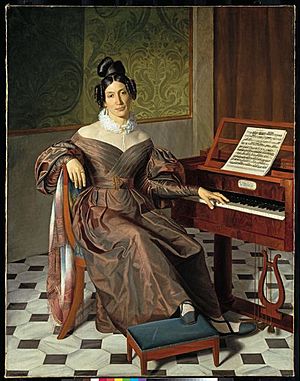Isabella Colbran facts for kids
Isabella Angela Colbran (2 February 1785 – 7 October 1845) was a Spanish opera singer known in her native country as Isabel Colbrandt. Many sources note her as a dramatic coloratura soprano but some believe that she was a mezzo-soprano with a high extension, a soprano sfogato. She collaborated with opera composer Gioachino Rossini in the creation of a number of roles that remain in the repertory to this day; they were married on 22 March 1822. She was the composer of four collections of songs.
Colbran in Naples
Colbran, born in Madrid, studied under Girolamo Crescenti in Paris. By the age of twenty she had achieved fame throughout Europe for her voice. She moved to Naples, a hub of European music during the eighteenth and nineteenth centuries. The Teatro di San Carlo, built during the Bourbon dynasty, had been home to famous singers like the castrato Farinelli and represented a destination venue for talented singers.
Colbran became the prima donna of the Teatro di San Carlo company, where she counted among her admirers the King of Naples as well as an adoring public. In time she became the mistress of the theater's impresario, Domenico Barbaia. Barbaia also managed gaming parlours and Colbran, materially well off as the result of her professional success and family fortune, developed a fondness for gambling.
To complement Colbran's talents Barbaia signed Gioachino Rossini to a seven-year contract as a composer of operas for the company. Upon his arrival in Naples in 1815 Rossini composed the title role of Elisabetta, regina d'Inghilterra (Elizabeth, Queen of England) especially for her. His next Neapolitan opera was Otello, ossia il Moro di Venezia in which Colbran sang the role of Desdemona. This opera proved to be immensely popular and found Colbran at the height of her powers. Her popularity led to demand for performances. Though her voice soon began to show signs of strain, Colbran continued to have a fertile career, creating the roles of Armida (Armida), Elcia (Mosè in Egitto), Zoraide (Ricciardo e Zoraide), Ermione (Ermione), Elena (La donna del lago), Anna (Maometto II), and Zelmira (Zelmira), all written by Rossini for Naples.
Colbran in Bologna
The artistic collaboration between Colbran and Rossini that began in 1815 was accompanied by a romantic involvement. Colbran moved with Rossini, seven years her junior, to Bologna in 1822, where they married. The death of her father hit Colbran hard. Rossini, moved, commissioned a sculpture for the family mausoleum depicting a woman weeping at the foot of her father's sepulchre.
The couple visited Vienna and later Venice, where Rossini composed Semiramide. Colbran created the title role, and even though the opera itself proved to be tremendously successful and was specifically designed to disguise her waning talents, she nonetheless disappointed the public. A visit to London in 1824 for a performance in the role commanded a high fee but received a poor critical response. After a disastrous appearance as Zelmira in 1824, she retired from the stage by the age of 42.
Colbran and Rossini separated in 1837 as the composer began a serious relationship with the artists' model Olympe Pélissier in Paris. Colbran's health went into decline and she continued to live on her deceased father's estate in Castenaso near Bologna. As her gambling habit became more acute, she sold off parts of the estate but Rossini continued to send support.
Colbran died in 1845 at age 60. She was buried near Bologna alongside her parents and Rossini's. Rossini married Pélissier the following year. All his life Rossini credited Colbran as being the greatest interpreter of his music.
Voice
Descriptions of Colbran's voice characterise the timbre as "sweet, mellow" with a rich middle register. Rossini's music for her suggests perfect mastery of trills, half-trills, staccato, legato, ascending and descending scales, and octave leaps. Her vocal range extended from F-sharp below the staff to E above, with a high F sometimes available.
Compositions
Colbran composed four song collections; they were dedicated to the Empress of Russia; to her teacher, Crescenti; to the Queen of Spain; and to Prince Eugène de Beauharnais.
See also
 In Spanish: Isabella Colbran para niños
In Spanish: Isabella Colbran para niños


